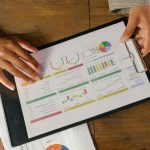If you want to enhance your work performance, creating a Quantified Self Dashboard for work metrics is a smart move. It helps you track your progress and stay aligned with your goals. Start by identifying your Key Performance Indicators (KPIs) and gathering data from various sources. But how do you choose the right tools and design an effective layout? Let’s explore the essential steps you’ll need to take.
Table of Contents
Key Takeaways
- Define SMART KPIs that align with your work goals, focusing on specific metrics like productivity or personal development.
- Gather data from existing tools, utilizing APIs for automation or manual entry via spreadsheets when necessary.
- Choose a dashboard tool that integrates easily with your data sources and offers customization for your specific metrics.
- Design your dashboard layout with organized sections, visual hierarchy, and interactive elements for an intuitive user experience.
- Regularly analyze your dashboard metrics, seeking feedback for improvements and focusing on actionable insights to drive performance.
Define Your Key Performance Indicators (KPIs)
When building your quantified self dashboard, defining your Key Performance Indicators (KPIs) is essential. KPIs serve as measurable values that indicate how effectively you’re achieving your goals.
Start by identifying what matters most to you—whether it’s productivity, health, or personal development. You’ll want to guarantee your KPIs are specific, measurable, achievable, relevant, and time-bound (SMART).
For instance, instead of saying “be more productive,” specify “complete three tasks daily.” This clarity helps you track your progress and make informed decisions.
Regularly review and adjust your KPIs to align with your evolving objectives. By establishing clear KPIs, you’ll be better equipped to monitor your performance and drive meaningful change in your life.
Gather and Integrate Data Sources
With your KPIs clearly defined, the next step is to gather and integrate data sources that will help you track your progress.
With clearly defined KPIs, the next step is to integrate data sources for effective progress tracking.
Start by identifying the tools and platforms you already use, such as project management software, time tracking apps, or communication tools.
Then, consider the following:
- APIs: Look for available APIs from your tools to automate data extraction.
- Spreadsheets: Use spreadsheets for manual data entry if APIs aren’t available; they can also help with data consolidation.
- Surveys: Implement surveys to gather qualitative feedback from your team, which can enrich your data insights.
Choose the Right Dashboard Tool
Choosing the right dashboard tool can greatly enhance your ability to visualize and analyze your data effectively.
Begin by evaluating your specific needs—what metrics are most important to you? Look for tools that offer customizable features, allowing you to tailor your dashboard to your preferences.
Popular options include Tableau, Google Data Studio, and Microsoft Power BI, each providing unique capabilities. Consider the ease of integration with your existing data sources; seamless connectivity saves time and effort.
Also, prioritize user-friendly interfaces, so you can quickly navigate and manipulate your data. Finally, think about collaboration features; if you’ll be sharing insights with a team, choose a tool that facilitates easy sharing and communication.
Design Your Dashboard Layout
A well-designed dashboard layout should prioritize clarity and ease of use, ensuring you can quickly access the information that matters most.
To achieve this, consider these key design elements:
- Organized Sections: Group related metrics together, so you can find what you need without scrolling endlessly. For example, keep productivity metrics separate from health data.
- Visual Hierarchy: Use size, color, and positioning to highlight important data. Larger numbers or graphs draw attention, while subdued colors can indicate less critical information.
- Interactive Elements: Incorporate filters and dropdowns that let you customize views. This way, you can drill down into specific periods or projects, making the dashboard more versatile.
Analyze and Iterate on Your Dashboard
As you gather data and insights from your dashboard, it’s essential to regularly analyze and iterate on its design and functionality.
Start by reviewing key metrics to identify trends and areas for improvement. Ask yourself which elements are most useful and which ones clutter your view. Adjust the layout or remove distractions that don’t serve your goals.
Engage with your data; filter out noise and focus on actionable insights. If you notice specific metrics are consistently underperforming, investigate further to understand the underlying issues.
Solicit feedback from colleagues or peers who use the dashboard, as fresh perspectives can lead to valuable enhancements.
Embrace a cycle of refinement, ensuring your dashboard evolves with your needs and helps you stay on track.
Frequently Asked Questions
What Are Some Common Mistakes to Avoid When Building a Dashboard?
When building a dashboard, you should avoid overwhelming users with too much information, neglecting data accuracy, and failing to take into account user needs. Keep it simple, relevant, and visually appealing to enhance usability and engagement.
How Often Should I Update My Dashboard Metrics?
You should update your dashboard metrics regularly to guarantee accuracy and relevance. Depending on your goals, consider weekly or monthly updates. This keeps your data fresh and helps you track progress effectively.
Can I Use Mobile Devices to Access My Dashboard?
Yes, you can definitely use mobile devices to access your dashboard. Just make sure your dashboard is optimized for mobile use, allowing you to track your metrics conveniently anytime, anywhere, straight from your smartphone or tablet.
How Can I Ensure Data Privacy and Security on My Dashboard?
To guarantee data privacy and security on your dashboard, implement strong passwords, use encryption, regularly update software, and limit access to authorized users. Stay informed about data protection regulations to maintain compliance and safeguard your information.
What Skills Do I Need to Create an Effective Dashboard?
To create an effective dashboard, you’ll need skills in data visualization, analytical thinking, and familiarity with relevant software. Understanding user needs and basic coding can also enhance your ability to present insights compellingly.




